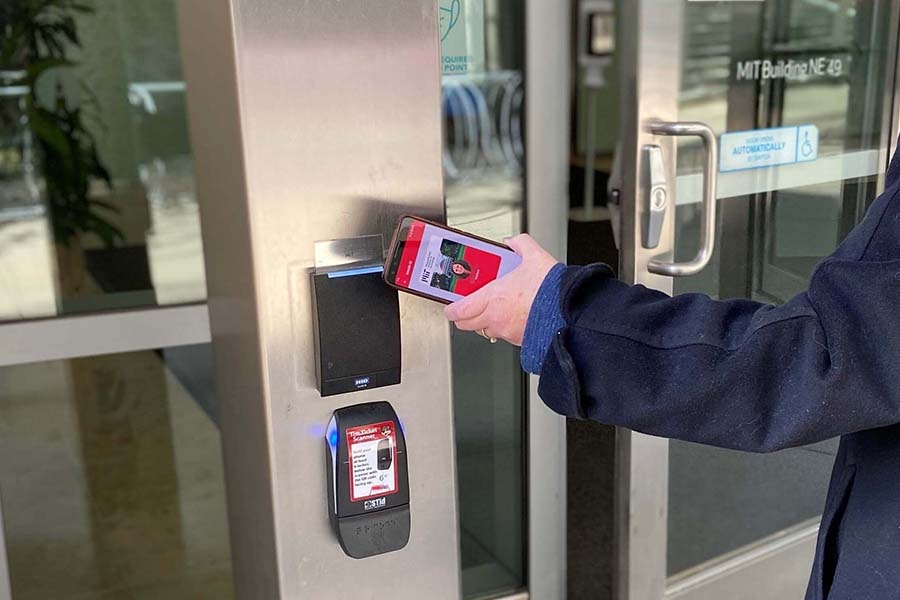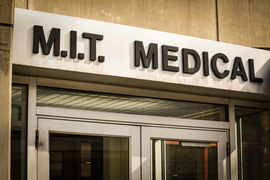MIT community members have a new and easier way to navigate campus life at the Institute: the MIT Mobile ID, a digital version of the MIT ID card for iOS and Android devices. Developed prior to the pandemic and released by Information Systems and Technology (IS&T), the MIT Mobile ID can be used just like a physical ID. A simple wave of your device — an iPhone, Apple Watch, or Android phone — near a reader is all it takes to open a door or pay for a coffee.
“The Mobile ID has made my life so convenient on campus overall this semester,” says Danielle Allison, a junior in mechanical engineering. “I can scan into buildings using my watch when my hands are full, and I have easy access to my TechCash and Pharos balances with a single tap.”
In fact, if you routinely walk around with your phone in your hand (or an Apple Watch on your wrist) the MIT Mobile ID will take on the same functionality that your physical MIT ID card does on campus, making it quicker and easier to do routine things such as accessing buildings and parking facilities, paying for food and beverages, and releasing Pharos print jobs. Moreover, if you keep your MIT Mobile ID in your Apple Wallet, you will also be able to view your TechCash and dining dollar balances.
"Throughout the pandemic, our community has been absolutely incredible as they have embraced a variety of new protocols that have helped to ensure the health and safety of the MIT campus,” says Mark V. Silis, vice president for information systems and technology. “The MIT Mobile ID was developed in an accelerated effort as part of the MIT Atlas program's continuing commitment to transforming the campus experience for our faculty, students, and staff."
Rapid adoption
After an invitation-only initial pilot phase, the MIT Mobile ID was announced to members of the undergraduate Class of 2025 during Orientation kickoff on Aug. 29. Adoption was swift, with about half of first-year students enabling their digital ID on day one.
As initial transaction data showed the Mobile ID was being used successfully across campus, IS&T proceeded with the full community rollout in mid-September. Since then, adoption and use has been strong. Currently, more than 14,000 community members have enabled their digital IDs. In October, Mobile IDs were used for almost 50,000 transactions (other than building access), more than doubling use in September.
Pre-Covid planning
In conjunction with the Department of Facilities, IS&T began planning for a digital version of the MIT ID back in September 2018. Before digital IDs could be offered to community members, a number of systems and devices would require upgrades or replacements.
Specifically, thousands of access card readers across campus would have to be upgraded. A new application to replace legacy physical access control software that Institute “gatekeepers” have used for decades to grant individuals access to specific spaces would need to be developed. Finally, engineers would have to design, test, and deploy the Mobile ID across a variety of devices.
Card reader replacement began in late 2019 and the rollout of the MIT Mobile ID was initially targeted for community-wide release in 2020. Work was proceeding as planned when the global Covid-19 pandemic hit.
Responding to pandemic challenges and opportunities
To safeguard the health and well-being of the community during the pandemic, MIT established requirements for those who access campus, including regular Covid testing and health attestations. With entry to Institute buildings restricted to those satisfying these requirements, ID cards quickly became vital to mitigating the effect of Covid and making life on campus as safe and seamless as possible.
However, this posed a new challenge, as MIT’s comprehensive measures to manage spread of the virus required issuing physical IDs to many additional people, including all vendors, contractors, and suppliers who supported campus operations. As campus began to reopen and with a commitment to the 2021-22 academic year being fully in-person, a more efficient and practical alternative to printing and managing so many plastic ID cards was needed. A digital ID could speed the onboarding process for new community members, allow for quicker and easier contactless interactions, and enable faster entry to campus spaces, since many people often have their phones in hand.
An additional challenge was determining how to deploy a digital ID across a variety of devices. Fortunately, there was a clear and convenient solution: the MIT Atlas mobile app. The Atlas app has become an essential tool for MIT community members during the pandemic, allowing them to keep up with health screening requirements to access Institute buildings and spaces, declare travel plans, upload vaccination information, and invite visitors to campus. As such, it was a natural platform for deploying the MIT Mobile ID.
A team effort
While the pandemic increased the urgency and scope of the digital ID project (for example, card readers would have to be added to many more building entrances), modernization planning and work done prior to Covid meant that IS&T and its partners didn’t have to start from scratch. As a result, much was completed in the 18 months from the pandemic outbreak to the start of the current school year.
“Teams from the Department of Facilities and IS&T did an incredible job upgrading more than 4,700 card readers, as well as hundreds of access control panels and intrusion alarm systems, at more than 120 buildings across campus,” says Marco Gomes, IS&T’s senior director of infrastructure operations.
Additionally, Gomes noted, team members completed this work while also performing various other critical activities in support of MIT’s safe return to operations. Thanks to those efforts, campus access is now fully integrated with the Covid Pass system, with the MIT Mobile ID playing a central role.
Future enhancements
While the MIT Mobile ID already offers many useful features, in the coming months IS&T and its partners across the Institute will continue to enhance and improve its functionality, including enabling the Mobile ID to be used as a T pass once the MBTA has enabled digital credentials.
In the meantime, MIT community members and affiliates should be sure to keep their physical ID cards, especially for the purposes of identification as well as for riding on the MBTA system. As cards may get lost or damaged, IS&T has made it easier for people to get a new or replacement card using the new self-service card-printing kiosk in the entryway of E17 at 40 Ames Street.
“We envision that the MIT Mobile ID will become an integral part of our campus fabric and help support our community in their efforts to keep us healthy and safe during these challenging times,” says Silis.



![Kyle Filipe working from home. "Our mentality is: keep telling us what you need and we'll keep trying to figure out creative solutions. That’s what [MIT IS&T] did before Covid-19 and that’s what we’ll do long after Covid-19.”](/sites/default/files/styles/news_article__archive/public/images/202005/kyle-filipe-information-services-and-technology.jpg?itok=Bnt3iuE7)





